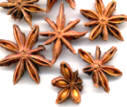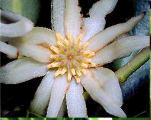Star Anise
Information about Star Anise plus Star Anise recipes
collection
Â
Â
Â
|
 |
Star anise is the dried fruit of a small to medium sized
evergreen tree, Illicium verum which belongs to the magnolia
family, Illiciaceae Magnoliaceae and grows up to 8m (26ft). |
Â
Origin and History
of Star Anise
Â
Native to China and Vietnam , today the star anise tree is mainly
grown in China, and Japan although it is also cultivated in Laos, the
Philippines, Indonesia and Jamaica. In China, apart from its use in
cooking, Mandarins used to chewed the whole dried fruit as a breath
freshener and it was also used for other medicinal purposes such as in the
treatment of colic, flatulence and nausea.
Â
It was first introduced to Europe in the 17th Century where it
was mainly used in baked goods and in the making of fruit compotes and jams as
well as in the manufacture of anise-flavoured liqueurs such as anisette and
Pernod, usually in the form of the oil
which is produced by a process of steam extraction.
Â
Cultivation of Star Anise
Â
 The
tree is propagated by seed and requires a lot of water in a well-drained, acid
soil to grow well. Although it takes 5 years to flower, and generally only
starts to bear fruit when it is 6 years old, it is a very long-lived tree and
often continues to bear fruit for almost 100 years. The fruit, or more properly,
seed pods, are harvested before they ripen after which they are sun-dried. The
red-brown, star-shaped seeds contain 5-10 oval sections up to 12mm/ � -inch in
length, each containing an oval seed. These pods are then either packaged whole
or ground ready for sale. Both the pods and the seeds are used when ground. The
tree is propagated by seed and requires a lot of water in a well-drained, acid
soil to grow well. Although it takes 5 years to flower, and generally only
starts to bear fruit when it is 6 years old, it is a very long-lived tree and
often continues to bear fruit for almost 100 years. The fruit, or more properly,
seed pods, are harvested before they ripen after which they are sun-dried. The
red-brown, star-shaped seeds contain 5-10 oval sections up to 12mm/ � -inch in
length, each containing an oval seed. These pods are then either packaged whole
or ground ready for sale. Both the pods and the seeds are used when ground.
Â
Â
Buying and Storing Star Anise
Â
It's best to buy whole stars which can not only be added directly
to the cooking pot either whole or in segments but can also be ground.Â
Stored whole it keeps for well over a year in an air tight container.
Â
Â
Star Anise
in Cooking
Â
Star anise has a powerful and liquorice-like aroma which isÂ
stronger than anise. Its flavour is reminiscent of a bitter aniseed albeit much
more pungent and harsher. It is one of the spices used in the spice mix called
Five-Spice and it is used in certain Chinese dishes such as red-cooked dishes
where meats are slow-simmered as well as some Vietnamese and Malaysian recipes.
Â
In the west it is traditionally used as a cheaper substitute for
anise seeds in fruit compotes, jams and in baking although its wonderful flavour
is now gaining favour in many savoury dishes, combining successfully withÂ
fish, poultry lamb and beef. It can also be used to substitute Anise seeds
in recipes - 1 crushed star anise = 1/2 teaspoon crushed anise seed.
Â
Â
Click
here for lots of Sweet & Savoury Star Anise Recipes
Â
|